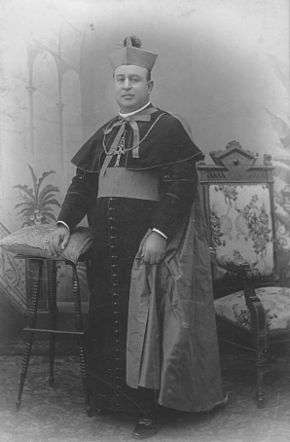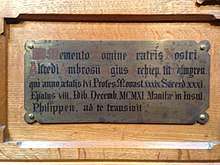Ambrose Agius
Ambrose Agius, O.S.B. (September 17, 1856 – December 13, 1911) was a Maltese[1] Archbishop of the Catholic Church.
His Excellency Ambrose Agius, O.S.B. | |
|---|---|
| Titular Archbishop of Palmyra | |
 | |
| Church | Roman Catholic |
| Appointed | 3 September 1904 |
| Term ended | 13 December 1911 |
| Predecessor | Jules-Basile Kandelaft |
| Successor | Antonino Sardi |
| Other posts | Apostolic Delegate to the Philippines (1905-1911) |
| Orders | |
| Ordination | 16 October 1881 |
| Consecration | 18 September 1904 by Rafael Merry del Val |
| Personal details | |
| Birth name | Tancredi Alfred Agius |
| Born | September 17, 1856 Alexandria, Khedivate of Egypt, Ottoman Empire |
| Died | December 13, 1911 (aged 55) Manila, Insular Government of the Philippine Islands, United States |
| Buried | Manila Cathedral, 1911 — 1945 Our Lady of Montserrat Abbey, Manila (1945 — present) |
| Nationality | Maltese |
| Denomination | Roman Catholic |
| Residence | Philippines |
| Parents | Tancredi Agius & Saveria Sammut |
A member of the Benedictine Order, Agius was appointed the Apostolic Delegate to the Philippines by Pope Pius X in 1904. Agius was delegated to canonically crown the image of Our Lady of La Naval de Manila in 1907. He founded the first Benedictine monastery in Malta, and ordained the first Filipino bishop in the Catholic Church.
Early life
Agius was born on September 17, 1856, in the Egyptian city of Alexandria (then under the Ottoman Empire), the second son (third child) of a Maltese merchant named Tancredi Agius and his wife Saveria Sammut.[2] Tancredi's children were:
- Edward Agius: 1849 - 1924
- Giulia Agius: 1854 - 1932
- Tancredi Alfred: 1856 - 1911
- Edgar Agius: 1864 - 1935
- Robert Agius: 1868 - 1874
Agius was baptized as Tancredi Alfred Agius at Saint Catherine's Cathedral in Alexandria on November 5, 1856. He returned with his family to Malta during his early years. Agius attended the college operated by the monks of St Augustine's Abbey in Ramsgate Kent, England, where he was an outstanding student. After he had completed his studies in 1872, he felt called to join the monastic community of the abbey. At his first profession of monastic vows, he was given the religious name of Ambrose. On October 12, 1873, he professed his perpetual vows and was then sent by his abbot to Rome to complete his studies in philosophy and theology.
Priesthood
Agius was ordained into the Catholic priesthood on October 16, 1881, at Subiaco Abbey.[3]
He became greatly immersed in Maltese culture as he traveled extensively in his early years.
In May 1881, Agius was instructed by the Holy See to open the first Catholic monastery in Malta. In December 1881, Agius, along with a group of Benedictine monks settled in Nigret, Żurrieq.[4] Under his supervision, a canonical religious community was begun, and a novitiate open to international candidates was set up. It was dedicated to the Immaculate Conception.
In 1884, the monastery was closed due to Italian-Maltese political turmoil, and Agius returned to Ramsgate to continue his religious mission. In 1893, he was appointed secretary to the Procurator of the Subiaco Congregation by Pope Leo XIII.
Appointment to the Philippines
On August 24, 1904, Pope Pius X appointed Agius as the Apostolic Delegate to the Philippines.[1] He was appointed Titular Archbishop of Palmyra on September 3, 1904, and received his episcopal consecration on September 18, 1904, at Sant'Ambrogio della Massima in Rome by the Cardinal Secretary of State Rafael Merry del Val.[5] Upon his appointment, Agius donated his celebration funds to the impoverished parishioners of the Basilica of Sant'Ambrogio.
In the Philippines, Agius canonically crowned the ivory statue of the Our Lady of the Most Holy Rosary of La Naval de Manila on October 5, 1907, representing Pope Pius.[6]
Agius convoked the 1907 Provincial Council of Manila with the other bishops of the nation at Manila Cathedral, re-dedicating the Philippines to the Immaculate Conception, which later became the country's official patroness under the pontificate of Pope Pius XII in September 1942.[7]
As Filipinos were previously barred from priestly ordinations and officially joining religious orders under Spanish colonial rule, on June 29, 1906, Agius ordained the first Filipino bishop in the Roman Catholic Church, Jorge Barlin y Imperial.
Death and burial
On November 1911, Pope Pius appointed Agius as the new Papal Legate to the United States. While preparing to travel to Rome, he died of an acute attack of peritonitis on December 13, at 55 years of age. On December 15, 1911, Agius was given a solemn Requiem Mass and was buried in the underground crypt of the Cathedral Basilica of the Immaculate Conception in Manila. The tomb survived the destruction of the cathedral due to bombing during the Battle of Manila in 1945. His remains were set into a smaller casket and moved to a new grave inside the Benedictine Abbey Church of Our Lady of Montserrat in Manila. The inscription translates as:
Ambrose Alfred Agius (1856 - 1911), Monk of Ramsgate, Titular Archbishop of Palmyra, Apostolic Delegate to the Islands, lies buried here; whose bones were formerly buried in the Cathedral basilica; which, destroyed by war, they were transferred to this Abbey church in the year 1945.

A memorial plaque was added to those for all the monks of Ramsgate Abbey in St Augustine's Church, Ramsgate with an inscription that translates as:
Remember Lord our brother Alfred Ambrose Agius Titular Archbishop of Palmyra who in the 56th year of his age the 39th year of his Monastic Profession the 31st year of his Priesthood and the 8th year of his Episcopate on the Ides [13th] of December 1911 in Manila in the Philippine Islands crossed over to you.
Nicknames
Agius was baptised as Tancredi Alfred Agius but was called Alfredo by his Italian-speaking parents or Alfred, when at school in Ramsgate (1871 Census). After taking his perpetual vows Agius became known as Dom Ambrose but was commonly referred to as Padre Ambrosio, Padre Ambo or Father Dom by the Filipino and Maltese faithful who knew him.
See also
- Archdiocese of Manila
- History of religion in Malta
References
- https://timesmachine.nytimes.com/timesmachine/1904/08/25/117946775.pdf
- Denaro, Marie (2003). Daughter of an Empire. A Family History. St. Julian's, Malta: David Arrigo Publishing. ISBN 99932-656-0-8., p.18-21
- "Archbishop Ambrogio Agius, O.S.B." Catholic-Hierarchy.org. David M. Cheney. Retrieved 21 January 2015.
- http://www.timesofmalta.com/articles/view/20120108/life-features/Sudden-death-of-Maltese-Benedictine-prelate-in-the-Philippines-100-years-ago.401664
- "Archbishop Ambrogio Agius, O.S.B." Catholic-Hierarchy.org. David M. Cheney. Retrieved 21 January 2015.
- http://www.sspxasia.com/Newsletters/2001/Oct-Dec/Our_Lady_of_the_Rosary.htm
- http://www.newadvent.org/cathen/09597b.htm
| Catholic Church titles | ||
|---|---|---|
| Preceded by Giovanni Battista Guidi |
Apostolic Delegate to the Philippines 1902-1904 |
Succeeded by Giuseppe Petrelli |